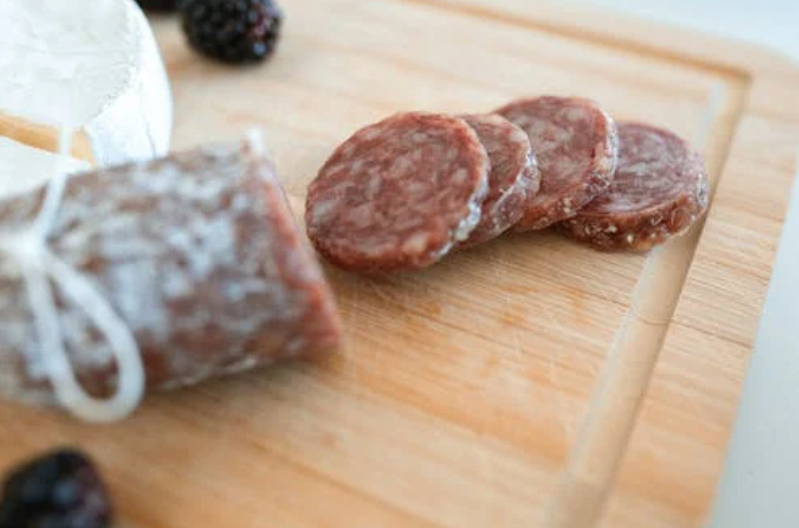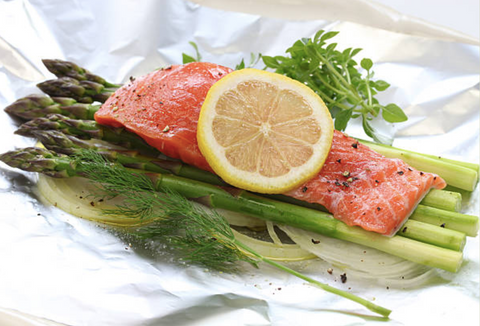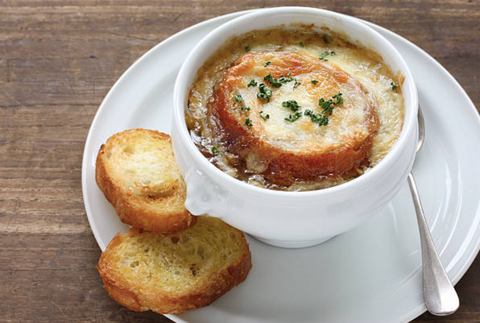French sausages are usually made from pork but can contain beef or veal. They are also commonly flavoured with garlic and mustard seed. In addition, French sausages are typically seasoned with salt and pepper. They're similar to English bangers in that they're made with pork meat and are plump, but they often contain other ingredients like spices, cheeses, meats (like duck or rabbit), nuts, or fruits (like figs). French sausages can be served cooked or raw.
How French Sausage is made
French sausages are made by grinding up meat and adding spices to create a mixture stuffed into a casing. There is no one way to make these sausages, so each company has its recipe for making this type of Sausage.
- The meat is ground up using large grinding machines that add all the spices and other ingredients needed for the Sausage to taste.
- Once the mixture is ground up, it is placed inside a casing and sealed off so it will have a uniform shape when it comes out of the machine.
- The casing used may be made of natural fibres or synthetic materials and is most often removed before cooking the Sausage because it can become tough during cooking.
Types of sausages
The term "sausage" covers an enormous array of pork products made in various ways. There are fresh sausages — loose, raw ground pork that must be cooked before eating — and cured sausages (like salami or pepperoni), which can be eaten raw. There is also a broad category of semi-cured links (like chorizo) that can go either way, depending on the type.
There are two main types of sausages in France:
Charcuterie - cooked, smoked or cured meat. Its products like salami, ham, pâté and rillettes. This type of Sausage is made from pork, poultry or fish and can be served hot or cold. These sausages are used as an appetizer with bread or crackers or as an ingredient in a dish.
Saucissons - dry-cured sausages. These sausages are usually served on a cheese plate with wine and bread. They can also be eaten uncooked as part of a sandwich or are sometimes used in salads or pasta dishes.
9 Most popular French Sausages
Boudin blanc de Rethel (white pudding of Rethel) is a French sausage made of pork without blood. It is a white sausage containing pork, milk, eggs, breadcrumbs, and onions. Unlike the similar longaniza and chorizo, there is no paprika added.
It is one of the oldest types of Sausage in France, originating in the Ardennes region. The name comes from the town of Rethel in northern France.
In France, it is eaten fried or grilled for breakfast. It also may be used as an ingredient in various dishes such as quiche or soup.
Knack d'Alsace sausages (French: Knack) are skinny pork sausages grilled with solid yellow mustard. They are typical of Alsace, and more generally, of the northeast of France.
Knack sausages have a deliciously light taste with a hint of wine and garlic. They can be eaten as an appetizer or added to salads, pasta or casseroles. Slice thinly or cut into cubes for salads, fry or grill whole for sandwiches or serve hot in soups or pasta dishes.
Saucisse de Montbéliard sausages are a speciality from the Doubs region of France, more specifically from the Montbéliard area. They are made with pork cuts and some beef. The mixture is seasoned with salt, pepper, garlic and other spices, then stuffed into natural casings and slowly smoked over fir or pine branches.
The resulting Sausage is dry and firm, with a lightly smoked flavour. It is often eaten raw or slightly grilled as an apéritif. These are also served cold, fried in butter or grilled on a plancha (griddle) over embers.
Diot sausages are traditional French sausages from the Savoie region, including white wine and onions. They are traditionally made from pork, salt, pepper and white wine. White wine is often referred to as "diot" in the Savoie region, hence the Sausage name. They're usually eaten with mashed potatoes or polenta.
Diot Sausage is an excellent ingredient for a multitude of dishes. These sausages can be cooked with potatoes, onions, or even scrambled eggs. Diot sausages are very famous in the Savoy region and are traditionally served during Christmas in the local dish, "Potonade."
Saucisse de Toulouse is a fresh, uncooked sausage that can be cooked and eaten right away or cured and dried to produce a dried link. It's one of the original sausages in France and is considered one of the five great charcuterie lumps of meat.
These sausages are made with fresh pork and are usually prepared with lentils. However, these can be used in many dishes. They're often grilled and served as the main course, but can also be poached or stewed with vegetables, added to stews, soups and bean dishes or used as an ingredient for stuffing or casseroles.
Andouillette is a coarse-grained sausage made with pork (or occasionally other offal) and chitterlings (intestines), traditionally from the intestines of a pig. However, some producers use those cattle or sheep.
After being grilled or heated in hot water, it is generally sold ready to eat. It is traditionally served on a plate with various condiments such as balsamic vinegar, mustard, mayonnaise, and tarragon sauce. A glass of white wine often accompanies it.

Saucissons is a type of thick, dry-cured sausage. It is usually made of pork but sometimes beef, mutton, venison or other meats. Saucissons are a popular snack in France, and they are mostly eaten when they are not fully cooked.
The French Chipolata is a type of pork sausage; it is usually fried or grilled and eaten as a breakfast dish in France. Chipolata is a thin sausage, often made from minced pork or pork liver and flavoured with salt and pepper. The French Chipolata is sometimes flavoured with other ingredients such as garlic, wine, or cognac.
Morteau sausage is a smoked, uncooked sausage made with pork originating from the Franche-Comté region in eastern France. It is traditionally made with raw ground pork and bacon (in a 1:1 ratio). It is then stuffed into natural casings, tied into short links, smoked over juniper branches for 20–24 hours, and finally dried for three weeks.
Sausages flavoured with Herbs:
The French are famous for their sausages, which they make in many ways. The most famous is the Sausage and the herbs. Like any other sausage, it is made with meat, fat, salt and pepper, and it is not cooked but smoked for a few hours. It is usually served with bread or fried potatoes.
The French have been making ham for centuries, and this one is from the 18th century. The ham is made from a pig's leg, and it is caused by salting it and then smoking it for about an hour. This ham is usually served with butter or mustard.
The French are also known for their cheese. There are many different varieties to choose from, including brie and camembert. Cheese has been a staple food in France for thousands of years and can be made from cow's milk or goat's milk. The French also like to eat cheese in salads and sandwiches, and they have often eaten with bread or crackers and fruits like apples or pears.
Do the French eat sausages for breakfast?
The French don't eat sausages for breakfast. Instead, they eat bread, butter and jelly, but not eggs. Europeans don't tend to eat a lot of meat in the morning. They'll have chorizo or pancetta in Spain, but it's more likely to be eaten as part of a sandwich or served with bread and olive oil as a snack. If you want to eat sausages for breakfast in France, you're better off going to England or Ireland.
- In the UK and Ireland, the traditional full English breakfast (a fry-up) does include bacon, eggs and sausages. However, it's prepared in many different ways; some people will grill their bacon and sausages together on a griddle pan in one go. Others will scramble the eggs with the bacon fat before adding them to the plate.
Bacon is generally sliced from the middle of a pig, whereas sausage meat comes from other parts. It's also seasoned differently, so it doesn't taste quite the same when cooked together on a griddle pan - although if you like your food salty enough, you may not notice much difference between them!
Although sausages are eaten throughout France, they tend to be lunchtime or evening meals. They are often served with a baguette or with sauteed potatoes and salad.
French Breakfast Sausages
However, French breakfast sausages are a bit different from English breakfast sausages. For one thing, they have pistachios in them! And for another, they're not encased – they're formed into little sausage patties and fried, so you get that nice crispy outside just like with a burger, Like
- One of my favourite things about this recipe is that it uses leftover cornbread. I always make too much cornbread when I make cornbread dressing, so I end up freezing it, and then I forget about it until I find it in there weeks later, like an afterthought from the holidays.
- Well, these French-style breakfast sausages are my new favourite use for leftover cornbread! They come together quickly and are delicious any time of day – I love to have them for brunch or dinner, with a side of eggs or roasted veggies.
- These sausages would be fantastic on a bun with maple mustard like we had at the Greenmarket, but if you're feeling fancy, you can serve them open-faced on English muffins too.
French sausages recipe
- Cut the top of each Sausage off and peel the skin off, keeping the meat in one piece.
- Place the meat in a bowl, and then add all the other ingredients, apart from the breadcrumbs.
- Mix it all together thoroughly with your hands, then leave to marinate in the fridge for 30 minutes.
- Add the breadcrumbs and mix again until well combined.
- Divide into four equal portions, and then roll each portion into a log shape about 3cm in diameter. Wrap each Sausage tightly in cling film and twist both ends to seal. Refrigerate for 1 hour before slicing into discs (or use immediately).
Famous French sausages in the UK
Cuts of meat used in charcuterie include pork, beef, game and poultry. The meat is usually cured (salted or smoked) or air-dried.
Some of the most popular types of French sausages in the UK are:
Andouillettes are a sausage made from small intestines that are often served fried with onions.
Boudin blanc – a white sausage made from pork, cream, egg and herbs.
Boudin noir – a blood sausage flavoured with herbs and spices such as cinnamon, cloves and nutmeg. The Sausage is traditionally served with applesauce.
Foie gras – a luxury food product made from goose or duck liver. It is produced by force-feeding birds using a feeding tube.
Wine with sausages
But sausages aren't only for breakfast and grilling. They're also great for a weeknight dinner — especially one that uses wine!
Sausages are very flavorful, so they pair well with wines with a little more acidity to balance the saltiness and fattiness. The suitable wine will make your dish even better by complementing the Sausage's flavours and bringing out new ones.
- When choosing which wine to pair with Sausage, it's essential to consider what else is in the dish (besides just sausages) as well as what kind of wine you'd like to drink (white or red?).
- It also helps to know how the sausage is made: Is it fresh or cured? Is it smoked or plain? What kind of meat is it made with?
Here are some general guidelines for pairing wine with Sausage:
Fresh pork sausage pairs well with fruity whites such as Riesling, Sauvignon Blanc, Gruner Veltliner, and Chardonnay. Try chicken or turkey sausage with Pin.
- First, understand the Sausage. For example:
Pork sausages
Duck sausages
Chicken sausages
Lamb sausages
- Then understand the wine. For example:
Red wine
White wine
Rose wine
- After that, match the Sausage to the wine! For example:
Pork sausages — Rose wine or White wine (dry)
Duck sausages — Red wine (dry), Rose wine (dry), or White wine (dry)
Chicken sausages — Rose wine (very dry) or White wine (dry)
Lamb sausages — Red wine (dry) or White wine (dry).
Lastly I would say that Sausages are one of the most versatile, delicious things you can make from ground meat. They're fantastic as part of a hearty breakfast or stuffed into grilled peppers and onions for a summertime barbecue. These French sausages can be used for perfect meal.




